
Slither Link
Encyclopedia
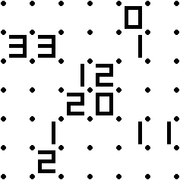
Logic puzzle
A logic puzzle is a puzzle deriving from the mathematics field of deduction.-History:The logic puzzle was first produced by Charles Lutwidge Dodgson, who is better known under his pen name Lewis Carroll, the author of Alice's Adventures in Wonderland...
developed by publisher Nikoli
Nikoli
Nikoli Co., Ltd. is a Japanese publisher that specializes in games and, especially, logic puzzles. Nikoli is also the nickname of a quarterly magazine issued by the company...
.
Rules
Slitherlink is played on a rectangular latticeSquare lattice
In mathematics, the square lattice is a type of lattice in a two-dimensional Euclidean space. It is the two-dimensional version of the integer lattice. It is one of the five types of two-dimensional lattices as classified by their symmetry groups; its symmetry group is known symbolically as p4m.Two...
of dots. Some of the squares formed by the dots have numbers inside them. The objective is to connect horizontally and vertically adjacent dots so that the lines form a simple loop with no loose ends. In addition, the number inside a square represents how many of its four sides are segments in the loop.
Other types of planar graphs can be used in lieu of the standard grid, with varying numbers of edges per vertex or vertices per polygon. These patterns include snowflake, Penrose
Penrose tiling
A Penrose tiling is a non-periodic tiling generated by an aperiodic set of prototiles named after Sir Roger Penrose, who investigated these sets in the 1970s. The aperiodicity of the Penrose prototiles implies that a shifted copy of a Penrose tiling will never match the original...
, Laves and Altair tilings. These add complexity by varying the number of possible paths from an intersection, and/or the number of sides to each polygon; but similar rules apply to their solution.
Notation
Whenever the number of lines around a cell matches the number in the cell, the other potential lines must be eliminated. This is usually indicated by marking an X on lines known to be empty.Another useful notation when solving Slitherlink is a ninety degree arc between two adjacent lines, to indicate that exactly one of the two must be filled. A related notation is a double arc between adjacent lines, indicating that both or neither of the two must be filled. These notations are not necessary to the solution, but can be helpful in deriving it.
Many of the methods below can be broken down into two simpler steps by use of arc notation.
Exactly 2 or 0 lines at each point
A key to many deductions in Slitherlink is that every point has either exactly two lines connected to it, or no lines. So if a point which is in the centre of the grid, not at an edge or corner, has three incoming lines which are X'd out, the fourth must also be X'd out. This is because the point cannot have just one line - it has no exit route from that point. Similarly, if a point on the edge of the grid, not at a corner, has two incoming lines which are X'd out, the third must also be X'd out. And if a corner of the grid has one incoming line which is X'd out, the other must also be X'd out.Application of this simple rule leads to increasingly complex deductions. Recognition of these simple patterns will help greatly in solving Slitherlink puzzles.
Corners
- If a 1 is in a corner, the actual corner's lines may be X'd out, because a line that entered said corner could not leave it except by passing by the 1 again. This also applies if two lines leading into the 1-box at the same corner are X'd out.
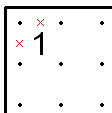
- If a 3 is in a corner, the two outside edges of that box can be filled in because otherwise the rule above would have to be broken.
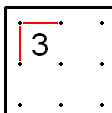
- If a 2 is in a corner, two lines must be going away from the 2 at the border.
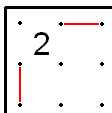
Rules for squares with 3
- If a 3 is adjacent to a 0, either horizontally or vertically, then all edges of that 3 can be filled except for the one touching the 0. In addition, the two lines perpendicular to the adjacent boxes can be filled.
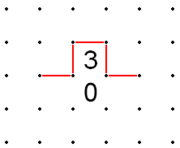
- If two 3s are adjacent to each other horizontally or vertically, their common edge must be filled in, because the only other option is a closed oval that is impossible to connect to any other line. Second, the two outer lines of the group (parallel to the common line) must be filled in. Thirdly, the line through the 3s will always wrap around in an "S" shape. Therefore, the line between the 3s cannot continue in a straight line, and those sides which are in a straight line from the middle line can be X'd out.
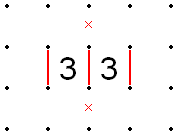
- If a 3 is adjacent to a 0 diagonally, both sides of the 3 that meet the 0's corner must be filled. This is because if either of those sides were open, the line ending in the corner of the 0 would have no place to go. This is similar to the 3-in-a-corner rule.

- Similarly, if a 3 has a corner with Xs in both directions going away from that corner, then both sides of the 3 that meet that corner must be filled. This is because if one of those two sides of the 3 were open, the other would have to be filled (because the 3 can only have one open side) but would meet 3 Xs at that corner, which is impossible because each point on the grid must have exactly 2 or 0 lines.
- If a line reaches a corner of a 3, there must be lines on both sides of the 3 that said corner is not adjacent to, because if the 3's sole empty space were not adjacent to it, the corner would have three lines connected to it. Furthermore, the segment leading away from the 3 at the corner reached by the line must be empty; if it were filled, neither of the remaining 2 undetermined sides of the 3 would be able to contain a line.
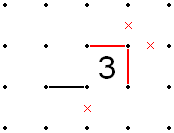
Diagonals of 3s and 2s
- If two 3s are adjacent diagonally, the edges which do not run into the common point must be filled in.
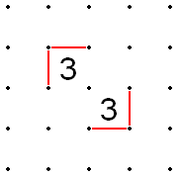
- Similarly, if two 3s are in the same diagonal, but separated by any number of 2s (and only 2s) the outside edges of the 3s must be filled in, just as if they were adjacent diagonally.
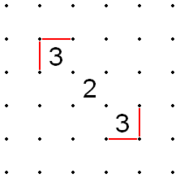
- If there is a series of 2s in a diagonal line and an angled line meets the corner of the 2 at one end of the series, a matching angled line can be drawn all the way up the series.

- Here there is a diagonal series of 2s ending in a 3. This example combines several of the rules illustrated above. The 2 at the end of the diagonal has an angled line which includes one (but not both) of the sides at its outer corner: the corner of the angle is at the 2's furthest corner from 3. This implies that both of the outer sides of the three must be filled. This is because: (i) the right-end side of the lower 2 must be empty so (ii) either the left or top line of the lower 2 must be filled so (iii) the middle 2 cannot have lines on both its right and bottom side (otherwise 3 lines would meet at its bottom right corner, which is not allowed) so (iv) it must have a line on either its top or left side so (v) the 3 must have both its top and left sides filled (see above). A similar chain of logic can be applied to any diagonal of 2s ending in a 3.
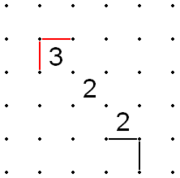
Diagonals of a 3 and 1
- If a 1 and a 3 are adjacent diagonally and the outer two sides of the 1 are X'd out, then the outer two sides of the 3 must be filled in.
- The opposite is the same: if the outer two corners of the 3 are filled in, then the outer two corners of the 1 must be X'd out.
A rule for squares with 2
If a 2 has any surrounding line X’d, then a line coming into either of the two corners not adjacent to the X’d out line cannot immediately exit at right angles away from the 2, as then two lines around the 2 would be impossible, and can therefore be X’d. This means that the incoming line must continue on one side of the 2 or the other. This in turn means that the second line of the 2 must be on the only remaining free side, adjacent to the originally X’d line, so that can be filled in.Conversely, if a 2 has a line on one side, and an adjacent X’d out line, then the second line must be in one of the two remaining sides, and exit from the opposite corner (in either direction). If either of those two exits is X’d out, then it must take the other route.
Rules for squares with 1
- If a line comes into a corner of a 1 and if one of the three remaining directions that the line can continue, the one that is not a side of the 1 is a known blank, then the two sides of the 1 opposite that corner can be X'd out.

- This also applies in reverse. That is, if a line comes into the corner of a 1, and the two opposite edges of the 1 are already X'd out, the line cannot go away from the 1 since that would put Xs around all sides of the 1.
- If two 1s are diagonally adjacent, then of the eight segments around those two cells, either the "inner" set of four segments sharing a common endpoint (the point shared by the 1s) or the other "outer" set of four segments must all be X'd out. Thus if any two inner or outer segments in one 1 are X'd, the respective inner or outer segments of the other 1 must also be X'd.
- If two 1s are adjacent along the edge of the grid, the line between them can be X'd out, because there would be no direction for it to continue when it reached the edge.
An even number of ends in a closed region
In a closed-off region of the lattice (from which there is no path for any lines to "escape"), there cannot exist an odd number of unconnected segment-ends, since all of the segment-ends must connect to something. Often, this will rule out one or more otherwise feasible options.Jordan curve theorem
In an exceptionally difficult puzzle, one may use the Jordan curve theoremJordan curve theorem
In topology, a Jordan curve is a non-self-intersecting continuous loop in the plane, and another name for a Jordan curve is a "simple closed curve"...
, which states that any open curve that starts and ends outside of a closed curve must intersect the closed curve an even number of times. In particular, this means that any row of the grid must have an even number of vertical lines and any column must have an even number of horizontal lines. When only one potential line segment in one of these groups is unknown, you can determine whether it is part of the loop or not with this theorem.
A simple strategy to assist in using this theorem is to "paint" (sometimes called "shade") the outside and the inside areas. When you see two outside cells, or two inside cells next to each other, then you know that there is not a line between them. The converse is also true: if you know there is no line between two cells, then those cells must be the same "color" (both inside or both outside). Similarly, if an outside cell and an inside cell are adjacent, you know there must be a filled line between them; and again the converse is true.
History
Slitherlink is an original puzzle of Nikoli; it first appeared in Puzzle Communication Nikoli #26 (June 1989). The editor combined two original puzzles contributed there. At first, every square contained a number.Videogames
Slitherlink video games have been featured for the Nintendo DSNintendo DS
The is a portable game console produced by Nintendo, first released on November 21, 2004. A distinctive feature of the system is the presence of two separate LCD screens, the lower of which is a touchscreen, encompassed within a clamshell design, similar to the Game Boy Advance SP...
handheld game console
Handheld game console
A handheld game console is a lightweight, portable electronic device with a built-in screen, game controls and speakers. Handheld game consoles are run on machines of small size allowing people to carry them and play them at any time or place...
, with Hudson Soft
Hudson Soft
, formally known as , is a majority-owned subsidiary of Konami Corporation is a Japanese electronic entertainment publisher headquartered in the Midtown Tower in Tokyo Midtown, Akasaka, Minato, Tokyo, Japan, with an additional office in the Hudson Building in Sapporo. It was founded on May 18, 1973...
releasing Puzzle Series
Puzzle Series
Puzzle Series is a brand of puzzle video games by Hudson Soft for the Nintendo DS and Wii game systems.-Titles:Games in the main Puzzle Series brand are collected as numbered volumes according to platform.-DS Puzzle Series:...
Vol. 5: Slitherlink in Japan on November 16, 2006, and Agetec
Agetec
Agetec is a US based video game publishing company that is best known for bringing Japanese titles to the US, including their flagship series Armored Core, and the King's Field RPG series, as well as their "designer series" of RPG Maker and Fighter Maker...
including Slitherlink in its Nikoli puzzle compilation, Brain Buster Puzzle Pak, released in North America
North America
North America is a continent wholly within the Northern Hemisphere and almost wholly within the Western Hemisphere. It is also considered a northern subcontinent of the Americas...
on June 17, 2007.
External links
- Nikoli's English page on Slitherlink
- On the NP-completeness of the Slitherlink Puzzle - Slitherlink is NP-completeNP-completeIn computational complexity theory, the complexity class NP-complete is a class of decision problems. A decision problem L is NP-complete if it is in the set of NP problems so that any given solution to the decision problem can be verified in polynomial time, and also in the set of NP-hard...
- Site discussing non-grid forms of Slitherlink including snowflake, penrose, laves and altair
- KwontomLoop - A free site with daily slitherlink puzzles varying in difficulty. Also includes a ranking system with other players.

